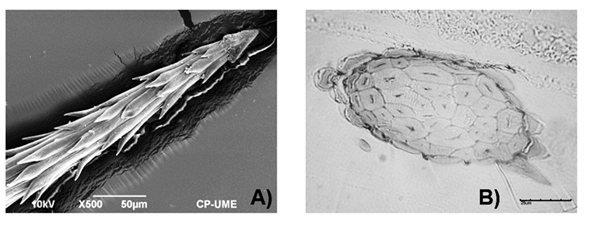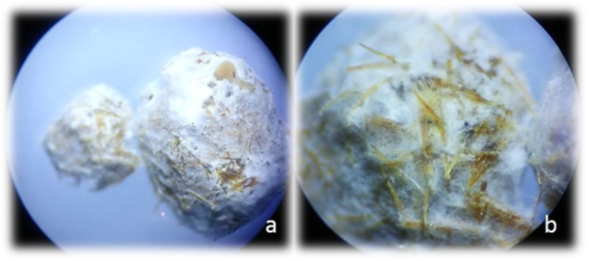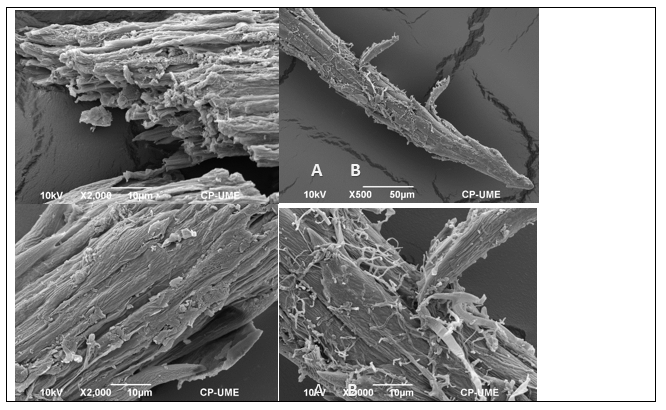eISSN: 2576-4462


Research Article Volume 9 Issue 1
Departamento de Suelos, Universidad Autónoma Chapingo, Mexico
Correspondence: María Edna Alvares-Sánchez, Departamento de Suelos, Universidad Autónoma Chapingo,. Km 38.5 Carretera México-Texcoco, Texcoco, Méx. México, CP 56230
Received: January 15, 2025 | Published: February 3, 2025
Citation: Alvares-Sánchez ME. Prickly pear glochids: Waste generation, properties and utilization potential. Horticult Int J. 2025;9(1):12-15. DOI: 10.15406/hij.2025.09.00317
In the prickly pear cactus production system, waste derived from prickly pear processing is discarded. Nowadays, agricultural production processes must be integrated into circular economy models as an opportunity to minimize environmental impacts and contribute to the sustainability of the system, an objective that is achieved through the development of co-products, i.e., creating added value to waste. The volume of glochids waste produced during the cleaning of the fruit is important not only because of the negative ecological impact of its disposal, but also because of the loss of material that is not used, to the detriment of the sustainability of the production system. The objective of this research was to gather available information regarding the physical characterization, chemical and nutritional properties, potential agronomic use and validation of co-products proposed for their possible use. This article presents key information for agribusiness management of one of the most significant and difficult to manage wastes for the prickly pear cactus production system.
Keywords: Chemical hydrolysis, reducing sugars, phytochemical properties, galacturonic acid, oligosaccharins, nutraceutical potential, agronomic potential
The prickly pear production system, like almost the entire agricultural sector, functions as an extractive linear production model, which, to produce fruit, in the process discards waste derived from the management of the plantation. Its cultivation is carried out by more than 20,300 producers, mostly in marginalized areas, and therefore represents an important source of income for them.1 In Mexico, the extension of prickly pear cactus plantations is approximately 51,000 ha with an average yield of 9.2 t ha-1 and a total production of 418,877 t per year.2 Of the 16 prickly pear producing states, the State of Mexico participates with 35.2% of the planted area and 37.3% of the production and an average yield of 10.4 t ha-1.
The processing of prickly pear cactus produces a residue of glochids or "ahuates", a material that is highly resistant to biological degradation and burning; it is difficult to handle because it can easily become embedded in people's skin or exposed mucous membranes, with the eyes and nasal passages being the most vulnerable.3 To dispose of this material, the producer collects it in plastic bags and discards it in fields and dumps, which has a negative impact on the environment. According to the mathematical model determined by Ulloa et al.3 to estimate the amount of waste produced in a period of 5 years, in Nopaltepec, State of Mexico, 80.1 t of glochids were generated from the production of prickly pear in 2532 ha, which were discarded in 5337 plastic bags (60x90 cm); this data highlights the negative impact on the environment and on the loss of biomass extracted from the system.
It is mandatory that agricultural production processes be integrated into circular economy models, as an opportunity to minimize environmental impacts and contribute to the sustainability of the production system through the development of co-products, i.e., to generate added value to waste.4-6 Given that the volume generated from this waste is significant, this research gathered available information related to the physical characterization, chemical and nutritional properties, and development of the potential use of the waste, up to the generation of a co-product, which are necessary steps in the definition of its possible use.7 With this information it is possible to generate viable proposals for the valorization of one of the most significant wastes for the tuna production system.
Structure and chemical composition of glochids
The difficulty to degradation of glochids is related to the hardness of their structure, associated with their degree of crystallization (20-60%) and alignment (1-2.5º) of cellulose fibers, which confer them similar or superior resistance to synthetic materials such as fiberglass.8
By Scanning Electron Microscopy (SEM), Ulloa-Leitón9 observed that the glochids have retrorse barbs along their entire structure (Figure 1A), which facilitates their adhesion to porous surfaces. The length is 1667±292 μm and their diameter is 67.3±9.56 μm; their density is 0.157±0.02 g mL-1. Fungal spores, that germinated when soaked in water, were identified among the retrorse barbs.

Figure 1 External structure of glochids (A); cross section of the glochid (B), at SEM.9
The hardness of these structures, among other characteristics of their composition, seems to be associated with cell walls that are very thick and consequently with a very reduced lumen (Figure 1B).
Cellulose, hemicellulose and lignin of the cell wall of the spines
The cell wall of glochids contains high proportions of cellulose (41.15 %±0.2%) as well as hemicellulose (41.2 %±0.2%) and only 5.27±0.2% lignin.2 It is known that cellulose is the polymer in the cell wall that is found in the form of microfibrils organized into fibers, whose cellulose chains are aligned parallel to the microfibrillar axis, an organization that gives the microfibrils high mechanical strength properties.
Nutritional content
Nutrient content analysis of glochids showed that they can be a source of macro- and micro-nutrients for crops (Table 1). If their contents are compared with commercial nutrient solutions, their contribution of macro- and micro-nutrients is higher than in Hoagland-Arnon, Steiner and Wynd solutions.10 Therefore, chemical hydrolysis of the structures has great potential for the agronomic sector.
|
|
N |
S |
P |
K |
Ca |
Mg |
Fe |
Cu |
Zn |
Mn |
B |
|
|
--------------------------------------------------- ppm ------------------------------------------------- |
||||||||||
|
Glochids1 |
4550 |
140 |
200 |
3610 |
4970 |
1120 |
2171 |
12.2 |
27.1 |
121.6 |
50 |
|
|
|
Commercial nutrient solutions 2 |
|||||||||
|
Hoagland-Arnon |
210 |
64 |
31 |
235 |
160 |
46 |
5 |
|
|
|
|
|
Steiner |
167 |
67 |
31 |
277 |
183 |
49 |
3 |
0.02 |
0.11 |
1.97 |
0.44 |
|
Wynd |
225 |
24 |
137 |
112 |
167 |
25 |
|
|
|
|
|
Table 1 Nutrient content of prickly pear glochids and their comparison with commercial nutrient solutions.
(Source: Ulloa-Leitón,9 Hewitt10)
Waste recovery potential
Mycelium and carpophore production of Pleurotus sp.
To date, there have been several studies that have assessed the potential for utilization of the residues. Given the lignocellulosic nature of the material and the germination of spores, which glochids can trap, when kept in water, it was envisioned that this material could be used in the production of mushrooms. In fact, the production of Pleurotus to produce high protein quality food.11,12
The propagation of Pleurotus spp. requires an inoculum developed mainly on cereal grains. Among the most used substrates for obtaining mycelium are sorghum, wheat, millet, corn and barley grains, which have cellulose contents between 23% and 35%, hemicellulose from 26% to 67% and lignin between 0.1% and 21%.13 This kind of substrate must provide carbon (from cellulose, hemicellulose and lignin), nitrogen and inorganic compounds as nutritional sources, and a particle size to allow adequate moisture and oxygen management.14 These last conditions could be covered also with prickly pear glochids, since their conformation and size can generate a larger contact surface, an indispensable quality for the development of the primary inoculum.15 Based on the above, De Jesús-Rivera16 evaluated the residue of glochids as an improver component of the sorghum grain substrate to produce mycelium of Pleurotus spp. The results indicated that its addition in a proportion of 30% to the traditional substrate (sorghum seed) contributed to increase the precocity of fungal invasion, promote a complete and homogeneous colonization and a very dense mycelium of cottony texture (Figure 2).

Figure 2 Glochids attached to sorghum grain invaded with mycelium (A); and granule of whole glochids colonized by Pleurotus spp. (B).16
Based on these successful results, the same researchers evaluated the glochid residue as a improver component of oat straw, in a 40% proportion, for the commercial production of Pleurotus spp. carpophores through the parameters of productivity, earliness and economic indicators. The straw-residue mixture significantly decreased the number of days required for colonization with respect to the control, with yield percentages of 38.3±10.9, biological efficiencies of 132.3±37.5% and production rates of 3±0.9%. The evidence was conclusive: agricultural waste in the ratio 40:60 (v/v) can be used as a substrate improver component to produce Pleurotus spp. The estimated economic benefits are summarized in savings in production costs and higher net profit with respect to traditional substrates to produce both mycelium and carpophores, in addition to the ecological benefits that its use could imply.17 In addition, stereoscopic observations showed that the hyphae break the crystalline structure of the glochids, which facilitates the manipulation of the residue (Figure 3).

Figure 3 Fractured structure of glochid after invasion process of Pleurotus spp. (A); cross section of the glochid and hyphae invading the structure (B).17
The substrate remaining from mushroom carpophore production presented pH 6.7±0.6; electrical conductivity 3.9 μS±0.14; bulk density 0.17 g cm-3±0.01; moisture holding capacity 26 %±1.59; total porosity 88.99%±0.38 and organic matter 63.6%±1.15. These characteristics indicate that it can be used as an organic component in the preparation of substrates or directly as a substrate in nurseries (Figure 4). Its properties compete with coconut fiber, a material widely used in hydroponics and fertigation.
Reducing sugars and their potential use as foliar fertilizers
Given the hardness of the glochid structures, Ulloa-Leitón et al.3 tested acid or alkaline hydrolysis methods to obtain a value-added input. The highest percentages of degradation and total reducing sugars were obtained from hydrolysis with sulfuric acid, phosphoric acid and potassium hydroxide. The first solubilized the greatest amount of minerals in the glycosides, of which K, Ca and Mg were the most abundant elements; P, N and S were the least concentrated; among the micro-nutrients, Fe stood out for its high content. From the hydrolysis of the glochids with sulfuric acid, phosphoric acid and 15% potassium hydroxide, foliar fertilizers were prepared in a 1:30 solid-liquid ratio and applied to roses of the rose Polar Star variety under greenhouse conditions. Preliminary results showed that the foliar fertilizer derived from hydrolyzed with sulfuric acid had a significantly favorable effect on peduncle length and prolonged vase life.9
Phytochemical properties and potential use
The glochids in contact with a polar aqueous medium release pigments with coloration similar to carmine red;3 these pigments may indicate the presence of compounds such as carotenoids, flavonoids, and betalains.18 Based on this observation, Marín-Campos et al.19 determined the phytochemical properties of pigments and pectic polysaccharides in hydrolysates of glochids of Opuntía albicarpa varieties Cristalina and Burrona. Spectrophotometric analysis showed that the extracts contained 16.2±3.4 mg and 20.6±1.2 mg-100 g-1 of total betalains in Cristalina and Burrona, respectively, with predominance of betacyanins. In both varieties total flavonoids were similar with 101.3±4.3 mg quercetin 100g-1 in Cristalina and 112.9±6.9 mg·100g-1 in Burrona. The concentration of total phenols was 427.4±18.4 mg·100g-1 and 385.7±17.0 mg-100g-1 in Burrona and Cristalina. The concentration of total pectins (expressed as galacturonic acid) was 128.7±26.7 mg-100g-1 and 35.6±17.3 mg-100g-1 of sample in Burrona and Cristalina. The contents determined in the residue, are comparable with those referred in other plant tissues exploited for the extraction of antioxidants, such as red pitahaya (Hylocereus polyrhizus),20,21 moringa (Moringa oleifera),22 quinoa (Chenopodium quinoa Willd) seeds;23,24 dried cranberry (Vaccinium macrocarpon);25 therefore, the glochids waste can be commercialized for the industry of natural pigments and antioxidant substances.
Oligosaccharins
Oligosaccharins are considered as a new hierarchy of hormones that exert a direct effect on the plant at the extracellular level. These endogenous compounds are multifunctional hormones in plant metabolism that depends on oligosaccharin composition, applied concentration, phenological stage and genotype.26
The knowledge and understanding of the physical structure of glochids, which show the ample cell wall thickness (Figure 1B), gave a glimpse that this waste could have potential as a source of pectic oligosaccharides, and thus exert a phytoregulatory effect on plants.19 The evaluation of foliar applications of endogenous oligosaccharins extracted by chemical hydrolysis27 at doses of 0 to 1.9 μg-mL-1 in the development of horticultural crops, showed significant positive effects of galacturonic acid (oligosaccharins) on the yield of squash flowers (Cucurbita pepo L.), leaf area, root biomass and height growth of Grey Zucchini variety; in onion (Allium cepa L.) on stem length, number of shoots, root biomass, foliage, stem diameter and bulb biomass; in tomato (Solanum lycopersicum) on basal and apical stem diameter. The magnitude of the effect depended on the dose, parameter evaluated and crop species. The results of this study compared with the values reported for commercial oligosaccharin products indicate that the by-product of prickly pear processing, which is currently discarded, has good potential for agronomic use.
This paper summarized the essential information on the amount of glochids residues generated per production cycle, which negatively impact the environment. The structural, physical and chemical characteristics detailing the residue were presented, essential information to define its possible applications, as well as results of experiments validating its conversion into a co-product. These wastes proved to be suitable to produce mycelium and Pleurotus spp. carpophores, with benefits in the reduction of inputs and production costs. Depending on the chemical hydrolysis used for the waste, reducing sugars can be obtained which, as a foliar solution, showed significant effects on the quality of the rose crop. Extracts containing oligosaccharins, which are growth hormones, are also another promising potential use for the nutrition, development and quality of horticultural crops. Its phytochemical and chemical properties, compared to other products used in the market, showed that it has potential for nutraceutical application as a biostimulant and foliar fertilizer for agricultural crops. The information provided and the experiments of its validation constitute an invaluable knowledge of the generation of added value from a waste product, key information for agribusiness management. If the innovation is achieved, it would contribute significantly to the sustainability of the tuna production system.
None.
There is no conflict of interest.

©2025 Alvares-Sánchez. This is an open access article distributed under the terms of the, which permits unrestricted use, distribution, and build upon your work non-commercially.